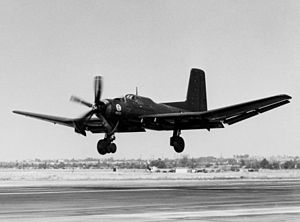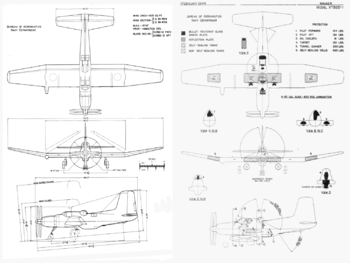- Douglas XTB2D Skypirate
-
TB2D Skypirate XTB2D-1 prototype Role Torpedo bomber Manufacturer Douglas Aircraft Company First flight 13 March 1945 Status Cancelled Number built 2 The Douglas TB2D Skypirate (also known as the Devastator II) was a torpedo bomber intended for service with the United States Navy's Midway class aircraft carriers; they were too large for earlier decks. Two prototypes were completed, but the dedicated torpedo bomber was becoming an outdated concept and with the end of World War II, the type was no longer needed, resulting in the project's cancellation.
Contents
Design and development
In 1939, Douglas designers, Ed Heinemann and Bob Donovan began work on a VTB Proposal to replace the TBD Devastator torpedo bomber. In 1942, the team led by Heinemann and Donovan began work on a new project named the "Devastator II". On 31 October 1943, just four days after the new Midway class aircraft carriers were ordered into production, Douglas received a contract for two prototypes, designated TB2D, receiving the official name: "Skypirate".[1] The TB2D was powered by a Pratt & Whitney R-4360 Wasp Major driving contra-rotating propellers. Four torpedoes or an equivalent bomb load could be carried on underwing pylons. Defensive armament consisted of two 20 mm (.79 in) cannon in the wings and .50 in (12.7 mm) machine guns mounted in a power-operated dorsal turret.[2]
Very large for a single-engined aircraft, the TB2D would have been the largest piston-engined carrierborne aircraft at the time if it had been deployed. It could carry four times the weapon load of the TBF Avenger and was larger, heavier and faster than a B-25 Mitchell bomber. With only limited support from the US Navy, and facing a recommendation for cancellation on 20 May 1944 due to the aircraft being designed only for the CVB and CV9 carriers, the TB2B project was in peril even at the design and mock-up stage.[3]
Operational history
The two "Skypirate" prototypes, BuNo 36933 and 36934 were ready for flight trials in 1945 with the first prototype XTB2D-1 flying on 13 March 1945. The second example had a 58 cm increase in the length of the fuselage, and flew later in summer 1945. Both prototypes were test flown without any armament. Despite the flying trials proceeding on schedule, the collapse of the Japanese forces in the Pacific along with delays in the Midway class, eliminated the need for the type and the 23 pre-production aircraft on order were subsequently cancelled. The flight trials were suspended and the two prototypes were eventually reduced to scrap in 1948.[4]
Specifications (TB2D Skypirate)
Data from McDonnell Douglas Aircraft since 1920 [5]
General characteristics
- Crew: 3
- Length: 46 ft 0 in (14.02 m)
- Wingspan: 70 ft 0 in (21.34 m)
- Height: 22 ft 7 in (6.88)
- Wing area: 605 ft² (56.2 m²)
- Empty weight: 18,405 lb (8,348 kg)
- Loaded weight: 28,545 lb (12,948 kg)
- Max takeoff weight: 34,760 lb (15,767 kg)
- Powerplant: 1 × Pratt & Whitney R-4360-8 Wasp Major radial engine, 3,000 hp (2,238 kW)
Performance
- Maximum speed: 340 mph (296 kn, 546 km/h)
- Cruise speed: 168 mph (146 kn, 270 km/h)
- Range: 1,250 mi (1,087 nmi, 2,013 km)
- Service ceiling: 24,500 ft (7,450 m)
- Rate of climb: 1,390 ft/min (7.2 m/s)
Armament
- Guns:
- 4 × wing mounted .50 in (12.7 mm) machine guns
- 2 × .50 in (12.7 mm) machine guns in dorsal turret
- 1 × .50 in machine gun in ventral bath
- Bombs: Up to 8,400 lb (3,810 kg) of bombs or four torpedoes
See also
- Aircraft of comparable role, configuration and era
- Related lists
References
- Notes
- ^ Baugher, Joe. "Douglas XBT2D Dauntless II." US Attack Aircraft via joebaugher.com, 24 October 2001. Retrieved: 7 June 2010.
- ^ Kowalski 1996, pp. 32–33.
- ^ "Memorandum: Cancellation of XTB2F Project - Recommendation for." Chief, BuAer, 20 May 1944. Retrieved: 7 June 2010.
- ^ Kowalski 1996, pp. 42–43.
- ^ Francillon 1979, p. 379.
- Bibliography
- Andrews, Harold: XTB2D -1. In: United States Naval Aviation News January 1982, pp. 20-21 [1]
- Francillon, René J. McDonnell Douglas Aircraft since 1920. London: Putnam, 1979. ISBN 0-370-00050-1.
- Kowalski, Bob. Douglas XTB2D-1 Skypirate (Naval Fighters number Thirty-Six). Simi Valley, CA: Ginter Books, 1996. ISBN 0-942612-36-1.
Douglas military aircraft Fighters Ground attack Naval bombers
and attack aircraftBombers Observation Patrol PD · P2D · P3D
Reconnaisance Transports C-1 · C-21 · C-32 · C-33 · YC-34 · C-38 · C-39 · C-41 · C-41A · C-42 · C-47 · C-48 · C-49 · C-50 · C-51 · C-52 · C-53 · C-54 · C-58 · UC-67 · C-68 · C-74 · C-84 · C-110 · XC-112/YC-112 · XC-114 · YC-116 · C-117 · C-118 · C-124 · YC-129 · C-133 · XCG-17
C-9 · C-24
RD · R2D · R3D · R4D (R4D-2 & R4D-4) · R5D · JD · R6D
CC-129 · Dakota I/III/IV · Dakota II · LXD1 · PD.808 · Skymaster ITraining aircraft Experimental USN/USMC torpedo aircraft designations pre-1962 Torpedo CTTEFTGreat LakesStoutSTTorpedo Bomber Great LakesTBGTBVPatrol Torpedo Bomber HallTorpedo Scout Lists relating to aviation General Aircraft (manufacturers) · Aircraft engines (manufacturers) · Airlines (defunct) · Airports · Civil authorities · Museums · Registration prefixes · Rotorcraft (manufacturers) · TimelineMilitary Accidents/incidents Records Categories:- Douglas aircraft
- United States bomber aircraft 1940–1949
- Carrier-based aircraft
- Aircraft with contra-rotating propellers
- World War II torpedo bombers of the United States
- Cancelled military aircraft projects of the United States
Wikimedia Foundation. 2010.



